Thursday, February 25, 2010
Cool, Short Alan Wilder Interview
Wednesday, February 24, 2010
Tuesday, February 23, 2010
On My Way Home
 Four connections in three countries and three trips through Customs. I'm in for a hell of a day.
Four connections in three countries and three trips through Customs. I'm in for a hell of a day. UNOPENED Bee Gees' Rhythm Machine on Ebay
Monday, February 22, 2010
Tonight: Assemblage 23 in Perm, Russia
 Tonight was to be the final date of my band's tour in Europe, but due to a Lufthansa pilot's strike, we have to cut the tour a date short to avoid being stuck in Russia for an extra 4 days. We apologize to our fans (if any) in Perm, but we'll make every effort to come back to make it up to you.
Tonight was to be the final date of my band's tour in Europe, but due to a Lufthansa pilot's strike, we have to cut the tour a date short to avoid being stuck in Russia for an extra 4 days. We apologize to our fans (if any) in Perm, but we'll make every effort to come back to make it up to you.
Sunday, February 21, 2010
Tonight: Assemblage 23 in Ekaterinburg, Russia
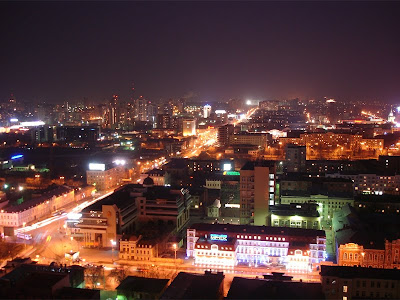 My band will be playing a show tonight in Ekaterinburg, Russia @ Tele-club for the first time. Come on out!
My band will be playing a show tonight in Ekaterinburg, Russia @ Tele-club for the first time. Come on out!
Saturday, February 20, 2010
Tonight: Assemblage 23 in Moscow, Russia
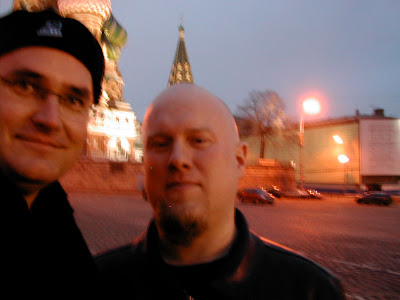
My band will be playing tonight with the always wonderful Mesh at Tochka in Moscow. Come out and drink silly amounts of vodka with us!
Friday, February 19, 2010
Synthesis Made Simple Part 12: Where Do You Go From Here?
 So, I hope by now that the basics of subtractive synthesis are at least a little more clear to you than before (assuming you're a noob). So what now?
So, I hope by now that the basics of subtractive synthesis are at least a little more clear to you than before (assuming you're a noob). So what now? Tonight: Assemblage 23 in Rostov-on-Don, Russia

My band will be performing tonight in Rostov-on-Don @ Podzemka. This'll be our first time playing here, so come on out and show us what you're made of!
Thursday, February 18, 2010
Synthesis Made Simple Part 11: Putting it All Together
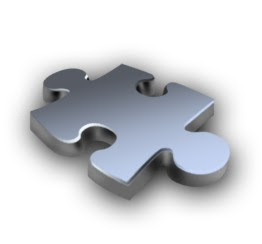 So over the past couple of weeks, we discussed the basic ingredients that make up most synthetic sounds you're likely to hear. As you might expect, many synths are a lot more complex and offer many more options than we've outlined here, but don't worry about that yet. What you've (hopefully) learned here accounts for most of what you need to make your own sounds. Get a good handle on this stuff first, and once you feel confident with these fundamentals, feel free to crack open the manual and learn about the more advanced stuff.
So over the past couple of weeks, we discussed the basic ingredients that make up most synthetic sounds you're likely to hear. As you might expect, many synths are a lot more complex and offer many more options than we've outlined here, but don't worry about that yet. What you've (hopefully) learned here accounts for most of what you need to make your own sounds. Get a good handle on this stuff first, and once you feel confident with these fundamentals, feel free to crack open the manual and learn about the more advanced stuff.Tonight: Assemblage 23 in Volgograd, Russia

If you happen to be in Volgograd, Russia tonight, my band will be in town playing a show @Zvezdny (and visiting our secret girlfriend Mother Russia...)
Wednesday, February 17, 2010
Synthesis Made Simple Part 10: Using Modulation Practically
 So by now, you should have a basic idea of the concept of modulation, and you've met the two most common modulators: the envelope and the LFO. To fill out your knowledge of modulation a bit more, this post will be less an article than it will be a couple of lists. The first of these will give you some definitions of other common modulators you might run into, and the second will be a list of various examples of ways you might want to modulate a sound and how to achieve it.
So by now, you should have a basic idea of the concept of modulation, and you've met the two most common modulators: the envelope and the LFO. To fill out your knowledge of modulation a bit more, this post will be less an article than it will be a couple of lists. The first of these will give you some definitions of other common modulators you might run into, and the second will be a list of various examples of ways you might want to modulate a sound and how to achieve it. Key Scaling/Following - This varies the amount of modulation that is applied to the modulator based on the position of the key on the keyboard. With a positive mod amount, the amount of modulation increases the higher the note you're playing is on the keyboard. You can guess what a negative amount would do. This is most commonly used on filter cutoff. Many times, the filter setting that is perfect for the low end of your keyboard is too dark or muffled in the higher notes, so this allows you to compensate for that and have higher cutoff values on them.
Tuesday, February 16, 2010
Synthesis Made Simple: Part 9 - Your Friend the LFO
 Last time around, we discussed envelopes, one of the tools you can use to perform automated modulation of various synth parameters. As you'll recall, envelopes are perfect for modulations that take place over time and happen once each time a key is pressed. So what if you need a modulation that repeats regularly? That just happens to be the strength of the LFO.
Last time around, we discussed envelopes, one of the tools you can use to perform automated modulation of various synth parameters. As you'll recall, envelopes are perfect for modulations that take place over time and happen once each time a key is pressed. So what if you need a modulation that repeats regularly? That just happens to be the strength of the LFO.Monday, February 15, 2010
Synthesis Made Simple Part 8: The Envelope, Please

In the previous post, I described a scenario in which you adjust the volume of your car radio as you’re driving to make it louder when a song you like comes on or to make it quieter when you get a ring on your cell phone. Nothing we probably haven't all done before, but all that fiddling about can be a bit distracting while you’re driving. Wouldn’t it be great if you had a little robot friend that could automatically adjust the volume knob for you? In a sense, that’s exactly what MODULATORS do - they automatically change whatever parameters they're assigned to, leaving your hands free to play. The most common type of modulator in the synth world is what is called an ENVELOPE.
Sunday, February 14, 2010
Tonight: Assemblage 23 in Glasgow, Scotland
 Come see my band tonight in Glasgow at the Classic Grand, ya wee girl! Oh - and... uh... happy Valentine's day.
Come see my band tonight in Glasgow at the Classic Grand, ya wee girl! Oh - and... uh... happy Valentine's day.
Saturday, February 13, 2010
Tonight: Assemblage 23 in London, England
 My band will be playing at 02 Academy Islington in London tonight... come say hello!
My band will be playing at 02 Academy Islington in London tonight... come say hello!
Friday, February 12, 2010
Synthesis Made Simple Part 7: An Introduction to Modulation
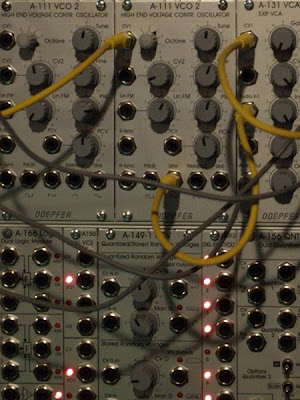
Imagine you’re driving in your car and your favorite song comes on the radio. You reach down to turn it up, but then your cell phone rings, so you turn it back down again so you can hear your phone conversation. In synth programming terms, you just MODULATED the AMPLITUDE of your radio.
What you have available to you to assign as a modulation source/destination depends on what synth you’re using. Some very simple synths may only allow you to use the mod wheel to add modulation in the form of vibrato on the oscillators. At the other extreme, well-appointed modular synths, will allow you to modulate virtually any parameter with any other parameter. Most synths fall somewhere in the middle, allowing you to assign a dozen or so different modulators to a few dozen different synth parameters. Regardless of these differences, the principle itself is always the same: a source modulates a destination via a positive or negative value.
We're going to talk some more about modulation a couple posts from now, but first I want to introduce you to the two most common modulation sources you will run into in your synth programming adventures: the envelope and the LFO.
Free Sample Friday: SH-101 Hard PWM Bass
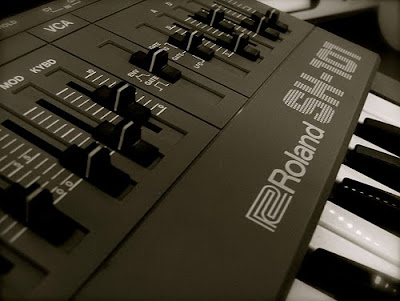 Another Friday is upon us and that means it's free sample time! Today's giveaway is a multi-octave, multi-sampled (9 notes) pulse width modulation synth bass courtesy of my Roland SH-101. Perfect for old school EBM or anything that needs a sort of hard-edged analog bass. Samples are mono 24-bit/44.1k WAV samples. Enjoy!
Another Friday is upon us and that means it's free sample time! Today's giveaway is a multi-octave, multi-sampled (9 notes) pulse width modulation synth bass courtesy of my Roland SH-101. Perfect for old school EBM or anything that needs a sort of hard-edged analog bass. Samples are mono 24-bit/44.1k WAV samples. Enjoy!Tonight: Assemblage 23 in Paris, France
 Tonight my band will be playing at Le Klub in Paris. Come on out if you've got nothing better to do!
Tonight my band will be playing at Le Klub in Paris. Come on out if you've got nothing better to do!
Thursday, February 11, 2010
Synthesis Made Simple: Part 6 - Types of Filter
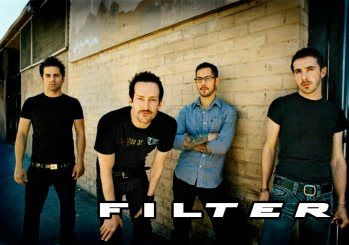
Well, no, not THAT filter. We're talking about synth filters. Sorry, Richard Patrick. Maybe next time.
As you’ll recall, we already discussed the basic function of a filter is to filter out frequencies past a user-defined “cutoff” point. But how do we know if it’s going to filter off the frequencies above or below the cutoff frequency? That’s where filter type comes in.
The LOWPASS filter is by far the most common type of filter you’ll come across. In fact, especially on older synths, it may be the ONLY type of filter you find. A lowpass filter filters out the frequencies above the cutoff value. In other words, it lets the frequencies beLOW the cutoff to PASS through. Get it? Low cutoff values will sound very dark and muffled (if at all), and as you increase the cutoff value, the sound will get brighter as you allow more high frequencies through. A healthy majority of the electronic sounds you have heard were probably made with a lowpass filter. Here is an example with 2 sawtooth oscillators, detuned a bit, and fed through a lowpass that sweeps from a low cutoff value to a high one and back:
A HIGHPASS filter is the exact opposite of a lowpass filter. It allows only frequencies ABOVE the cutoff point through (it lets the frequencies HIGHer than the cutoff frequency PASS through), so as you increase the cutoff value, more and more low frequencies are filtered out. The higher the cutoff, the less bassy the sound will get until you’re left with only the high frequencies, and eventually, nothing is left. Depending on how they're used, highpass filters can sound light and airy, or aggressive and acidic and get a lot of use in the Goa/Psytrance music. Here's the same sound as above, but sent through a highpass filter:
A BANDPASS filter is sort of what you would expect if a lowpass and a highpass filter were combined (in fact, you can replicate a bandpass filter if you have both a lowpass and highpass simultaneously available like on the Korg MS-20). A bandpass filter filters off the frequencies both above AND below the cutoff frequency, leaving only a relatively narrow BAND of frequencies PASS through. Bandpass filters have a sort of nasal quality and add a really nice variation from the more standard lowpass and highpass filters. Here's our example sound, but this time it's being fed through a bandpass filter.
You may recall that when we first started talking about filters, I mentioned how filters could be used to simulate the way a guitar sound goes from a bright initial sound, fading to a more muted sustain. Having these filters is great, but if you just leave it set to a static cutoff value, all you really have is a glorified bass/treble knob. Sure, if your synth has knobs, you could manually change the cutoff value with each note you played to emulate this effect, but wouldn’t it be great if there was a way your synth could do this automatically for you? Actually, it can! Next post, I’ll introduce the concept of MODULATION to you and you’ll begin to see how a synthesizer can achieve more interesting, dynamic sounds out of the relatively simple architecture we’ve discussed so far.
































